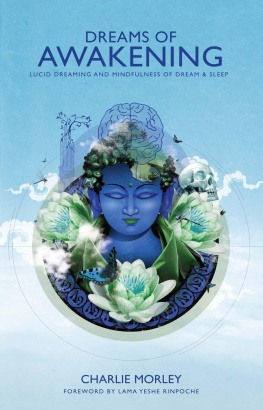SUNY series in Dream Studies
Robert L. Van de Castle, editor
INTEGRAL DREAMING
A Holistic Approach to Dreams

Fariba Bogzaran and Daniel Deslauriers

Cover art designed by the authors and illustrated by Gwendolyn Jones.
Published by
STATE UNIVERSITY OF NEW YORK PRESS
Albany
2012 State University of New York
All rights reserved
Printed in the United States of America
No part of this book may be used or reproduced in any manner whatsoever without written permission. No part of this book may be stored in a retrieval system or transmitted in any form or by any means including electronic, electrostatic, magnetic tape, mechanical, photocopying, recording, or otherwise without the prior permission in writing of the publisher.
For information, contact
State University of New York Press
www.sunypress.edu
Production, Laurie Searl
Marketing, Kate McDonnell
Library of Congress Cataloging-in-Publication Data
Bogzaran, Fariba, 1958
Integral dreaming : a holistic approach to dreams / Fariba Bogzaran and Daniel Deslauriers.
p. cm. (SUNY series in dream studies)
Includes bibliographical references and index.
ISBN 978-1-4384-4237-2 (hbk. : alk. paper)
1. Dreams. I. Deslauriers, Daniel, 1958 II. Title.
BF1091.B62 2012
154.6'3dc23
2011027894
10 9 8 7 6 5 4 3 2 1
To the memory of our mothers
for their support of our creative endeavors
and of the pursuit of our dreams.
Figures
Acknowledgments
We are grateful to many people who have helped us while writing this book. We jointly thank Bob Van de Castle, editor of SUNY Press's series in Dream Studies, and Jane Bunker, former associate director and editor-in-chief at SUNY Press. Both were enthusiastic about this book and waited patiently for several years. We thank SUNY Press senior editor Nancy Ellegate and senior production editor Laurie Searl for working with us throughout the process.
We want to thank our editor, Nancy Adess, and our colleagues Elizabeth Shaver, Kimmy Johnson, and Karen Jaenke whose feedback were invaluable. We thank Gwen Jones for helping us in designing the illustrations that grace this book and Monika Tomaszewska, Ezra and Anna Mikeda for technical assistance. We are deeply appreciative of Lynne Ehlers for her participation in this book: through countless hours of interviews, her willingness to share her process brought heart and meaning to our philosophy of practice.
We each individually want to thank special people in our lives. From Fariba: I honor my early mentors in consciousness studies from whom I learned science, phenomenology, and integral studies: Daniel Kortenkamp and Hamid Hekmat (University of Wisconsin); Bill Wynne (University of Regina, Canada); Yi Wu, James Kidd, and Ralph Metzner (California Institute of Integral Studies); and Stephen LaBerge (Stanford University). I give my heartfelt gratitude to my mentors who taught me the art of practice: T'ai Chi master Pi Lu Fei; shaman Joska Soos; Reichian Ed Jackson; Dzogchen master Lama Tharchin Rinpoche; painters Gordon Onslow Ford, John Anderson, and Matta. My appreciation reaches out to the graduates of the Dream Studies Program at John F. Kennedy University: my reward is to be the witness of your blossoming. Three colleagues at JFKU were pillars of support while I created the program: David Goldberg, Vernice Solimar, and Nancy Slocum. Thank you for believing in my vision and for the gift of our deep friendship.
From Daniel: I wish to acknowledge and thank my mentor George W. Baylor for his teachings, sometimes unbearable, on how to lead life with joyful purpose. One day I will find the best recipe for Sauce Aurore! I also wish to thank the late Alan Moffitt and his associates at the Chronopsychology Lab at the University of Carleton, Ottawa for opening their doors to me in order to pay my dues to science. Those forty nights inverting my sleep pattern were like crossing the desert of consciousness! I am also indebted to my colleagues in the East-West Psychology and Transformative Studies Programs at the California Institute of Integral Studies (CIIS) and especially all my students who put their trust in their dreams. Their openness and deep questioning allowed all of us to enter the mystery of dreams together. I wish to thank Judie Wexler, dean of faculty at CIIS, for providing the right atmosphere for scholarship. Merci Apela Colorado for her fervent and subtle support and prayers on this journey. And to my friends in Quebec who supported me in many ways, and who demanded regular progress reports, especially Dominique Major, Marie-ve Pelletier, Laurette Dupuis, and Marc Valois, I say merci infiniment!
We give our gratitude to late James Hillman, late Montie Ullman, Harry Hunt, Gordon Globus and Ken Wilber whose works have been an intellectual inspiration for both of us.
Many friends and colleagues listened to our process for years while we were writing this book: thank you to Patricia Garfield, Jayne Gackenbach, Rita Dwyer, Stan Krippner, Tore Nielsen, Don Kuiken, Barbara and Denis Tedlock, Mary Dombeck, Elizabeth Zarlengo, Yalda Kamrani, Runa Gustafsson, Emily Anderson, Christiam Nabadon, Carol Sipper, Daniel Rybold, Marilyn Fowler, Atom Patten, Barbara de Franco, Keelin, Robert Snyder, Sharon Kehoe, the late Vicki Helms, Ngawang Zangpo, Zayra Yves, and many others. Esta Feedora, Badri, Nima, and George provided the best encouragement: they constantly insisted we should just go out and play rather than write. They teased us to the brink of completion! Our colleague and friend Marc Barasch once told us writing a book is an isolating affairone can disappear for years. We now understand what you meant, Marc!
We want to acknowledge the support of our brothers Faramarz, Franois, Guy, Louis-Jean, and Ramin who were, along with their families, very patient with us for our lack of participation in family functions while working on this project. Thank you for your understanding.
Finally, during the process of writing this book we had two major losses: Daniel's mother and Fariba's father passed. They constantly heard us talking about this book. We wish they were with us todaywe know well that they would have rejoiced the most.
Introduction
Dreaming is the art of the mind. Every dream is intrinsically a creative experience. As the artists of the night, we are co-participants in weaving new creations from the complexity of our entire being. Dreaming forms an integral part of who we are. Becoming familiar with our dreaming life becomes increasingly important to a life of self-inquiry and self-understanding. Not only do dreams spur insight and personal growth, they also help us understand the creative nature of the mind.
The emerging field of dream studies has formed from many coalescing strands: the analytical power of science, the cumulative knowledge of wisdom traditions, the insights of modern psychology, and the renewed interest in human consciousness. Several competing theories and approaches have tried to explain the nature, functions, and creative use of dreaming. With so many exciting avenues of inquiry, the amount of information and the wide range of perspectives on dreams can be overwhelming. How does it all connect?
Integral Dreaming brings a connective voice and an expansive approach to the field of dream studies. Its holistic perspective springs from the idea that we are multidimensional beings, that dreams are multidimensional events, and that there are multiple ways of viewing and gaining insights into dreams. We use the word
Next page









